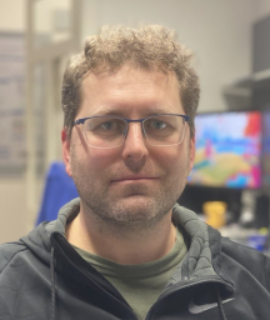Title : Imaging of chemical kinetics at the water–water interface in a free-flowing liquid flat-jet
Abstract:
Two cylindrical liquid microjets are set up in a colliding geometry to generate a planar leaf-shaped flowing sheet. Using jets with two different aqueous solutions, each containing a reactant for a fast chemiluminescence reaction, we image the emitted photons to spatially visualize the mixing of the solutions at any position of the leaf – see Figure 1 [1]. We observe that under laminar flow conditions mixing in the first leaf happens differently compared to all consecutive leafs since the first leaf remains dark while all consecutive leafs show a homogeneous chemiluminescence glow. In the first leaf no turbulent mixing takes place in the planar region. Instead diffusion across the planar liquid-liquid interface leads to mixing of chemical species from the two solutions, also leading to chemical reactions and their chemiluminescence detection. We exploit this micrometer-thin flowing two solution structure for spectroscopic and kinetic studies at the liquid-liquid interface. We present a quantitative model that describes diffusion-limited reaction kinetics at the liquid-liquid interface, which can also be extended to account for interactions at the liquid-vapour interface. I will conclude with an overview of the current ongoing research.
Audienece Takeaway:
- The audience will get an introduction to different ways of liquid flat-jets generations – micrometer thin liquid sheets – which they could adopt to their purposes. In fact flat-jets have started to be employed in numerous experiments such as collision studies, high-harmonic generation of light and to study chemical reactions. The audience will also learn how we made use of the unexpected flow dynamics and mixing properties of these flat-jets and how they allow the possibility to study diffusion limited kinetics given our special case of a very fast chemiluminescence
- reaction
- I will show the audience in the FLUID DYNAMICS session how we imaged the turbulent and diffusive mixing dynamics using a fast chemical reaction – something that be used in many other hydrodynamic applications or setups. Furthermore, it should be helpful to see and to discuss how the model to describe diffusion controlled kinetics can also be adapted to other systems. This research connects the fields of HYDRODYNAMICS, especially the mixing dynamics within laminar flow, CHEMICAL REACTIVITY and chemiluminescence, and REACTION KINETICS.
- Typical leaf surface dimensions are 1.5 mm × 0.5 mm with flow velocities of a few 10 m/s corresponding to a flow time through the first leaf of around 50–100 μs. This covers a time scale for chemical kinetics that is currently difficult to access by other Figure 1: Blue chemiluminescence indicates the position where mixing of two liquids happens. methods. Indeed, conventional stopped-flow techniques are best suited for studies on time scales around a millisecond, while laser-induced techniques work best on faster time scales.
- The flat-jets free flow through air or vacuum permits unobstructed optical access to
- the liquid and thus enables a wide range of spectroscopic detection – i.e. photoelectrons – that are incompatible with many solid container materials.


